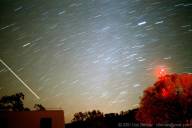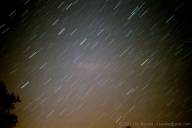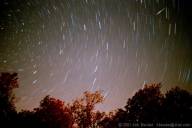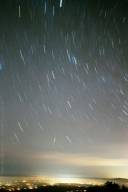
2:40 am, 10 minute exposure, 28mm lens, f2.8.

3:16 am, 15 minute, 28mm, f2.8

3:37 am, 15 minute, 28mm, f2.8

4:10 am, 15 minute, 28mm, f2.8
Unbelievable, I'll probably never see as many meteors in my life.
I didn't keep count, but at the peak I saw maybe one every 2 or 3 seconds.
I stayed up until 30 minutes before dawn, and they were still falling.
I put the camera on a tripod and left the shutter open for 10-15 minutes, so most of the streaks are not meteors but stars leaving trails because the earth is rotating. The meteors are the streaks going "against the grain", in a different direction from the stars. The meteors appeared to come out of, or radiate from, the constellation Leo, hence the name Leonids.
Images taken with a Pentax 35mm SF1 camera, on Kodak Royal 1000 color print film, scanned onto Kodak Picture CD, and brightness and contrast adjusted a little in Paint Shop Pro. I didn't do any research on meteor photography beforehand, so I was really glad I caught any meteors at all, and that the pictures weren't horribly over or under exposed.. I knew the longer the exposure I made, and the widest angle lens I used, the more chance I had of catching some.
click on an image to see a larger version.
Kirk's Homepage email: kbender@znet.com
last updated 2001/11/25
Images and text copyright (C) 2001 Kirk Bender, all rights
reserved. Void beyond geosynchonous orbit.